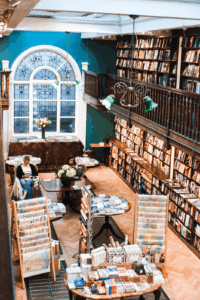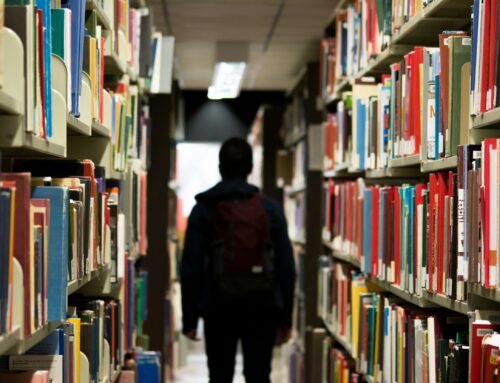 The Revival
The Revival
At first, brick-and-mortar bookstores thrived amongst readers, but the recent past has shown how various factors, including digitalization, have affected their success. Additionally, giant corporations like Amazon swooped in and became the new villain as drastic discounts and the creation of Kindle e-readers threatened to wipe out printed books and subsequent bookstores entirely.[1] These effects took place before the COVID-19 pandemic, causing worry amongst brick-and-mortars for their future, especially considering the factor of quarantining. And yet, data depicts that within 2022, the American Booksellers Association (ABA) observed continuous growth as members of the organization maintained more than 2,500 locations, showing more than a 50 percent increase since 2009.[1] But, how exactly have brick-and-mortar bookstores sustained these successes? What is it that makes them so desirable to readers?
Many readers find that simply the experience of being inside a bookstore and browsing the various genres is a major factor of their appeal. While individuals have observed how Amazon carries essentially every book and does so at lower prices, there is a distinguishable quality in buying books from a bookstore that Amazon cannot digitally replicate: the act of holding physical books and browsing shelves within different departments to which enhances a reader’s experience.[2] In an article reviewing a piece written by journalist Ezra Klein titled The Unlikely Bookstore of My Dreams, responses suggest that the browsing of physical books also gives readers the opportunity to explore other genres and even pick up a classic that they’ve been meaning to read.[2] Klein specifically reflects upon how it is not only part of the experience to buy these books, but also in simply being amongst them as their presence serve as continuous reminders of evolving interests and book tastes over the years.[2] The simple presence of bookstores and their physical copies give readers an experience unlike anything that digital purchasing is capable of, showing the impact of visiting these brick-and-mortar stores and having a quality, personalized experience.
Adding to this personalized experience is the presence of community in brick-and-mortar bookstores and how this facet has allowed businesses to have an impact and embrace the diversity surrounding them.[3] Communities alike have shown immense support towards the small businesses, seeing that their effect is immense in the act of unity and representation. Specifically, the ABA had examined the increased diversity in the business owners of these bookstores, where an 11 percent growth of its membership in 2023 included the addition of “ 58 [bookstores] owned by Black, Indigenous, and other people of color.”[3] This observable rise in diversity illustrates a strong presence of innovation in these environments, providing additional enhancement towards the overall experience.
Alongside these concepts, because of their sense of community and impact, brick-and-mortar bookstores work to continually express the significance of books within society. This impact has not only allowed these businesses to foster a close-knit community, but has also shown how the people within such are collectively working to support the businesses and instill permanence in their presence within said community.[3] The knowledge prevalent within these communities of bookstores’ impact is a result of the placed importance on books, where there is a sense of freedom presented in the knowledge and overall experiences that they bring to readers. Within an article from USA Today discussing the “new chapter” of brick-and-mortar bookstores, author Phaedra Trethan reflects upon the observations of a business owner within the field, where they identify how stories/books have been an integral asset of technology for many years, illustrating their plentiful nature as they teach us valuable elements such as empathy and knowing of the world around us.[3]
The revival of brick-and-mortar bookstores has shown significant improvements in both the reader and community experiences present, giving readers alike various opportunities for growth, impact, and a greatly enhanced reading experience. But, what should brick-and-mortar bookstores do in order to sustain these successes? What exactly should remain consistent, and what should be further improved/developed?
The Future
The diverse positives of visiting/supporting your local brick-and-mortar bookstores are extremely evident, therefore making it all the more important to preserve their existence within communities. One major element that has continuously been presented as a threat is digitalization. As the rise of e-readers occurred and online resources vastly improved, many physical bookstores were shut down and the remaining businesses were forced to compete with technological advancements.[4] As a result, brick-and-mortar bookstores sought out specific growth potentials to draw more people into their stores. Some of these aspects included cultural activities, art exhibitions, cafés, etc.[4] Specifically, Barnes & Noble and Starbucks exemplify the product of such, creating a “strategic alliance” by building cáfes in the bookstore. In doing so, they hoped to entice the public to buy more of Starbucks’ coffee while simultaneously increasing book buyers in B&N stores.[5] Such alliances served to illustrate how businesses were able to diversify their sources of income while also making the physical book-shopping experience more appealing to the public. This then instills sustainability of their presence within communities through the elements of “transformation, adaptation, and innovation.”[4] In continuously implementing these aspects within brick-and-mortar bookstores, their future prosperity will be certified as the book shopping experience will continue to evolve and connect to readers’ habits and interests.
Additionally, the spread of indie bookstores will perpetuate these positive connotations. In one specific example, an article examines the effects of a bookstore located in Florida that works with self-published authors. In their work, they allowed authors to reserve a shelf and display their works, giving them the opportunity to advertise their work to the public.[6] In continuously implementing similar businesses in the future, brick-and-mortar bookstores can continue to thrive in the success of their business, and in the aiding of small/newer authors looking to market themselves.
By and large, brick-and-mortar bookstores’ revival has shown resilience in their purpose, serving to enhance a reader’s experiences and not only inspire people to shop for physical books, but also share the experience in doing such with the community surrounding them. Ensuring the continuation of their success will give these concepts grounds to grow and flourish, illustrating how important it is for us readers to support these small businesses.
How Does PSG Fit In?
Here at PSG, we value the representation of brick-and-mortar bookstores and the many benefits they serve towards readers. As a result, we aim to strive for the same effects within our own work, polishing and refining content to foster environments containing these positive elements. In this, we can represent the positive values of brick-and-mortar bookstores and potentially work with clients within these businesses, ensuring the works within are at their greatest potential.
[1] https://wng.org/articles/return-of-the-bookstore-1675827601
[2] http://link.gale.com/apps/doc/A736858935/CDB?u=nhc_main&sid=bookmark-CDB&xid=98525b9d
[3] https://www.usatoday.com/story/news/nation/2024/09/01/independent-bookstores-thriving/74797026007/
[4] https://buscompress.com/uploads/3/4/9/8/34980536/riber_10-3_03_h19-129_39-67.pdf
[5] https://www.linkedin.com/pulse/innovative-successful-strategic-alliance-amid-market-neha-gupta-1c/
[6] https://www.publishersweekly.com/pw/by-topic/authors/pw-select/article/68003-standalone-brick-and-mortar-store-for-self-published-authors-to-open-in-florida.html
Photo free to use under the Unsplash License.




